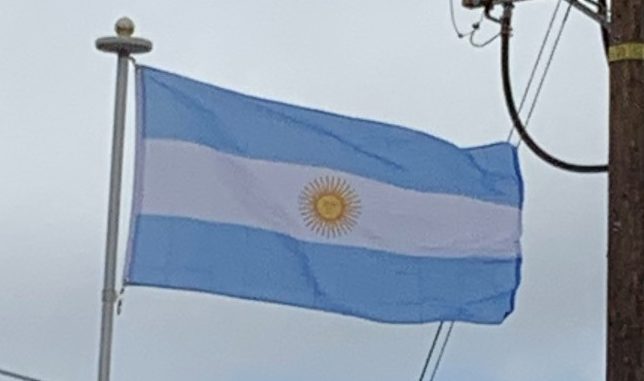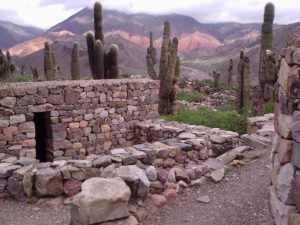
Colonial Era:
Europeans first arrived in the region with the 1502 voyage of Amerigo Vespucci. The Spanish navigators Juan Díaz de Solís and Sebastian Cabot visited the territory that is now Argentina in 1516 and 1526, respectively. In 1536 Pedro de Mendoza founded the small settlement of Buenos Aires, which was abandoned in 1541.
Further colonization efforts came from Paraguay—establishing the Governorate of the Río de la Plata—Peru and Chile. Francisco de Aguirre founded Santiago del Estero in 1553. Londres was founded in 1558; Mendoza, in 1561; San Juan, in 1562; San Miguel de Tucumán, in 1565. Juan de Garay founded Santa Fe in 1573 and the same year Jerónimo Luis de Cabrera set up Córdoba. Garay went further south to re-found Buenos Aires in 1580. San Luis was established in 1596.
The Spanish Empire subordinated the economic potential of the Argentine territory to the immediate wealth of the silver and gold mines in Bolivia and Peru, and as such it became part of the Viceroyalty of Peru until the creation of the Viceroyalty of the Río de la Plata in 1776 with Buenos Aires as its capital.
Buenos Aires repelled two ill-fated British invasions in 1806 and 1807. The ideas of the Age of Enlightenment and the example of the first Atlantic Revolutions generated criticism of the absolutist monarchy that ruled the country. As in the rest of Spanish America, the overthrow of Ferdinand VII during the Peninsular War created great concern.
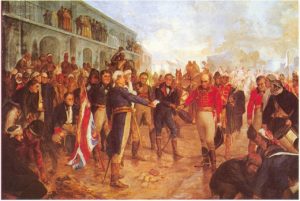
Independence and Civil Wars:
Beginning a process from which Argentina was to emerge as successor state to the Viceroyalty, the 1810 May Revolution replaced the viceroy Baltasar Hidalgo de Cisneros with the First Junta, a new government in Buenos Aires composed by locals. In the first clashes of the Independence War the Junta crushed a royalist counter-revolution in Córdoba, but failed to overcome those of the Banda Oriental, Upper Peru and Paraguay, which later became independent states.
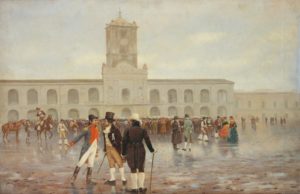
Revolutionaries split into two antagonist groups: the Centralists and the Federalists—a move that would define Argentina’s first decades of independence. The Assembly of the Year XIII appointed Gervasio Antonio de Posadas as Argentina’s first Supreme Director.
On 9 July 1816, the Congress of Tucumán formalized the Declaration of Independence, which is now celebrated as Independence Day, a national holiday. One year later General Martín Miguel de Güemes stopped royalists on the north, and General José de San Martín took an army across the Andes and secured the independence of Chile; then he led the fight to the Spanish stronghold of Lima and proclaimed the independence of Peru. In 1819 Buenos Aires enacted a centralist constitution that was soon abrogated by federalists.
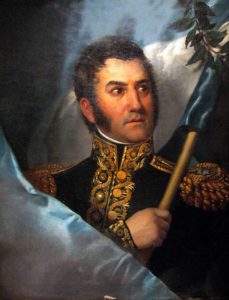
The 1820 Battle of Cepeda, fought between the Centralists and the Federalists, resulted in the end of the Supreme Director rule. In 1826 Buenos Aires enacted another centralist constitution, with Bernardino Rivadavia being appointed as the first president of the country. However, the interior provinces soon rose against him, forced his resignation and discarded the constitution. Centralists and Federalists resumed the civil war; the latter prevailed and formed the Argentine Confederation in 1831, led by Juan Manuel de Rosas. During his regime he faced a French blockade (1838–1840), the War of the Confederation (1836–1839), and a combined Anglo-French blockade (1845–1850), but remained undefeated and prevented further loss of national territory. His trade restriction policies, however, angered the interior provinces and in 1852 Justo José de Urquiza, another powerful caudillo, beat him out of power. As new president of the Confederation, Urquiza enacted the liberal and federal 1853 Constitution. Buenos Aires seceded but was forced back into the Confederation after being defeated in the 1859 Battle of Cepeda.
Rise of the Modern Nation:
Overpowering Urquiza in the 1861 Battle of Pavón, Bartolomé Mitre secured Buenos Aires predominance and was elected as the first president of the reunified country. He was followed by Domingo Faustino Sarmiento and Nicolás Avellaneda; these three presidencies set up the bases of the modern Argentine State.
